Alabama is rich with foraging opportunities. There are many types of wild edibles found throughout the state, including ingredients for your next salad, plenty of edible mushrooms, and an array of delicious wild berries. Today we’ll be taking a closer look at the berries you’ll find once you start seeking them out in the wilds of Alabama or your own backyard.
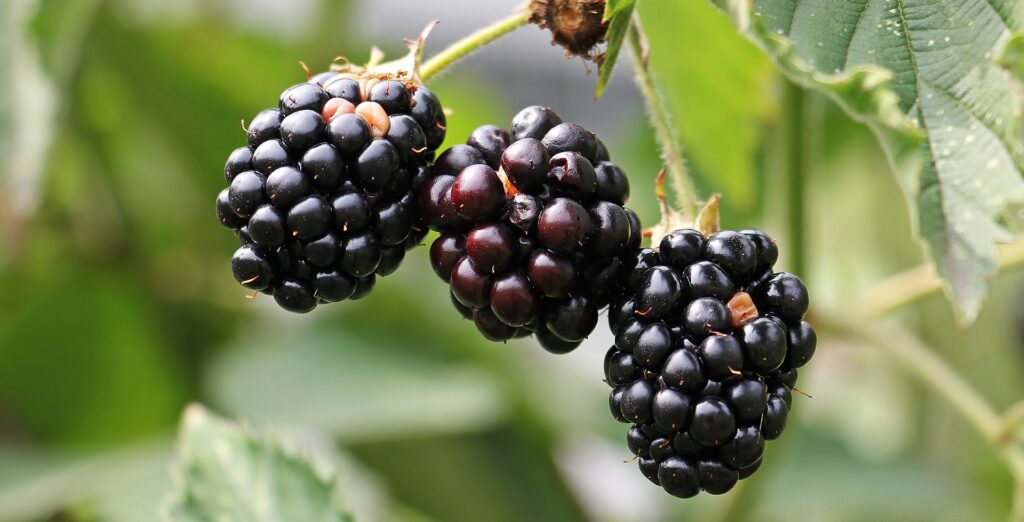
Blackberries (Rubus spp.)
Wild blackberries are very much like the ones you find in grocery stores or farmers markets, so you’re likely to be familiar with them. Unfortunately, many people consider blackberry plants to be weeds. They’re a common plant in Alabama, and since they grow in such abundance on vines thick with thorns. Consequently, a lot of people don’t want them in their yards. For this reason, you’ll need to employ an extra sense of caution and question where the blackberry plant is growing before you decide the wild blackberries are safely edible.
Are these blackberries near a well-maintained park, garden, or someone’s yard, where they might have sprayed the plant with herbicide to stop its growth? Then you don’t want to eat the blackberries because they might be contaminated with chemicals. Similarly, if the plant is growing along the side of the road in a ditch, the plant is constantly absorbing pollutants from car exhaust. Be very mindful about where the plant you’ve found is growing, think about chemicals, and use your best judgment when foraging for wild blackberries.
With that warning in mind, wild blackberries are everywhere in Alabama. They are sweet, tart, rich in antioxidants, and easy to pick by the bucketful. They’re great for snacking, mixing into smoothies, or as an ingredient in baked goods. Many people freeze their blackberries to keep them around all year.
In the early spring, you’ll spot white flowers. You’ll start seeing bright glossy edible berries appear in June and July.
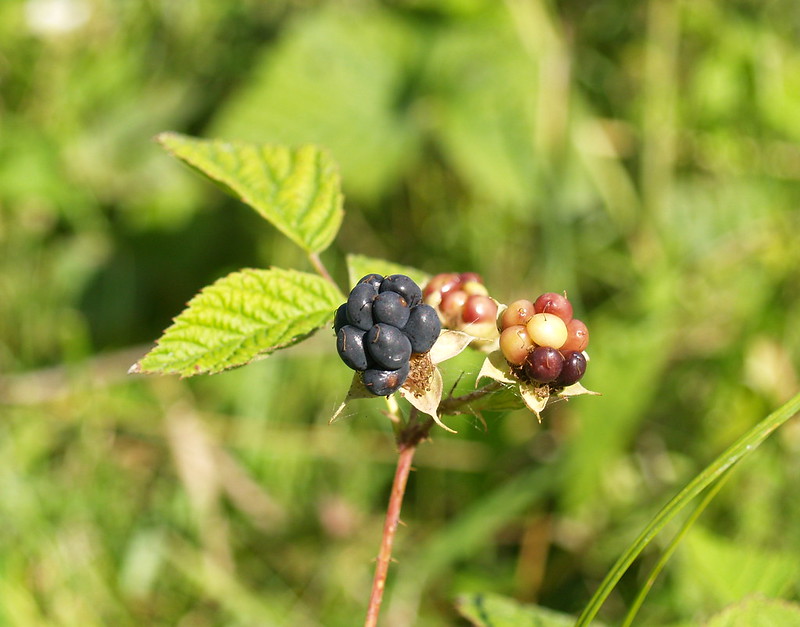
Dewberries (Rubus trivialis)
Dewberries are very similar to blackberries. They’re from the same genus. They taste similar. They both grow on vines and thorny bushes. One difference is that blackberry plants grow in upright bushes. While they sprawl, there is more height to them. Dewberries prefer to grow out to the side in trailing brambles.
Look for yellow flowers in early spring, which give way to the scrumptious berries in April or May. Dewberries are a great precursor to Blackberries in June and July. You can eat dewberries, similar to how you enjoy blackberries.
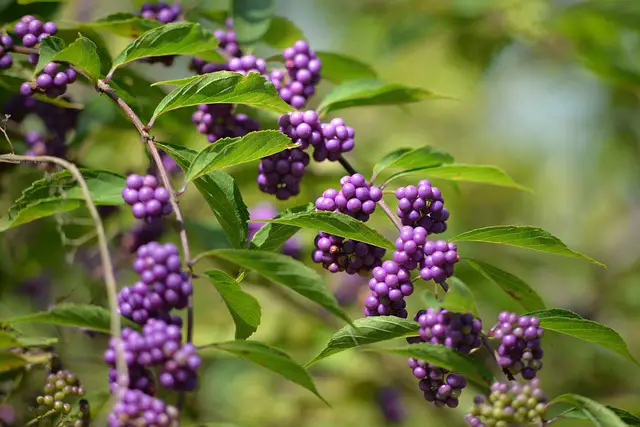
Beautyberry (Callicarpa americana)
The beautyberry plant is a native species to Alabama and the surrounding states. As the name suggests, beautyberries are stunning. Locals love growing them in their gardens. They grow on a shrub that averages three to five feet in height. In perfect growing conditions, though, they can double those numbers. The shrub has smooth bark that is light brown when the plant is young and reddish brown as the shrub ages. In the spring, you’ll find pink flowers on its arching branches. Later, you’ll find bright pink-purple berries.
American beautyberries are ready to harvest in October. You may find non-native Asian varieties of beautyberries, which ripen a few months earlier.
Birds and deer love these brightly colored berries, so you’ll be competing with animals for beautyberries as a food source. These berries have a somewhat bitter, tangy taste, and not everyone enjoys the flavor. Many people who do enjoy beautyberries consume them in teas or use them in baked goods where they are sweetened with other ingredients.
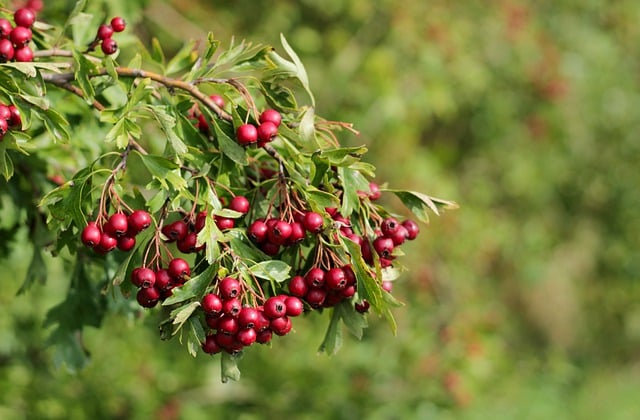
Mayhaws (Crataegus aestivalis)
You can’t talk about wild edibles in the South without talking about Mayhaws. Nearby states, including Louisiana and Arkansas, have popular Mawyhaw festivals. The edible fruit is berry-sized and grows on hawthorn trees. The fruits are sometimes yellow, sometimes red, and sometimes shades in between. The fruit has a mild flavor. Most people don’t eat mayhaw’s raw, though you can do so. Mayhaws are usually eaten in jelly. Many families in Alabama plant the trees in their yard or know a favorite foraging spot, gather a large amount together, and then make a fresh batch of mayhaw jelly every spring.
As the name suggests, Mayhaws are ready to be harvested in the month of May. You’ll find the trees in the wild growing near a water source.
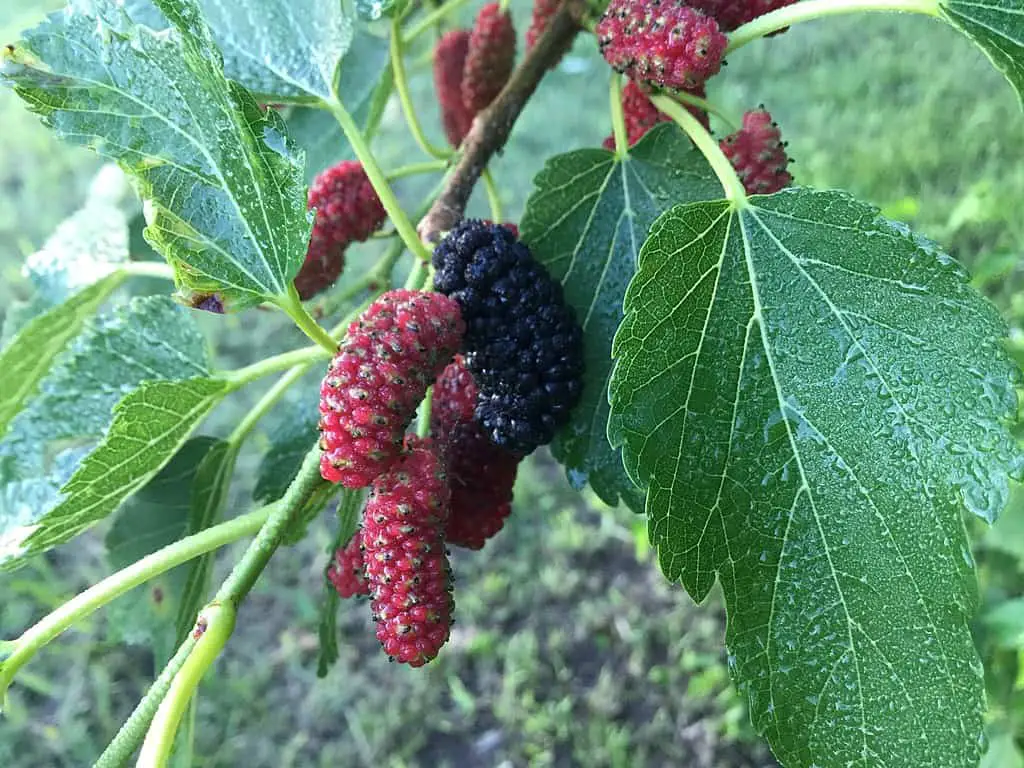
Mulberries (Morus spp.)
Mulberries look like someone took a raspberry and stretched it out some. They have a sweet flavor that makes them popular with foragers, but many allergy sufferers hate their heavy pollen. The Mulberry tree is a deciduous tree and a common sight in fields, along roadsides, and in public parks. You’ll see them growing in many family-oriented neighborhoods.
They grow throughout the United States and make a delightful wild edible. You can find black and red mulberries, which darken up and often look dark purple when they’re ready to harvest. Or, you can find white mulberries, which will be white or a golden color when they’re ready for consumption. The plants have glossy leaves. They are ready for picking over a two to four-week period, so you’ll want to get to them quickly. Mulberry trees are usually ready for harvest in June.

Elderberries (Sambucus spp.)
Elderberries are only edible when they are cooked. Do not eat raw elderberries. This can be confusing when we know the berries are edible since you’ll see elderberry syrup and jam as a popular option at farmer’s markets in Alabama. They make great fruit for pies and wines as well. In these recipes, the elderberries are naturally cooked, the seeds are strained out, and the fruit is safe to eat.
Elderberries are a powerhouse of nutrients, rich in vitamin C and antioxidants. You’ll find them growing in areas with dense vegetation, so look for them off the main path when you’re on a hiking trail. They like moist soil, so a good water source will be nearby.
Elderberries grow in clusters. They are small, black or blueish black, and have large, flat-topped white flowers in the early summer. You can start looking to harvest elderberries in mid-August through September.
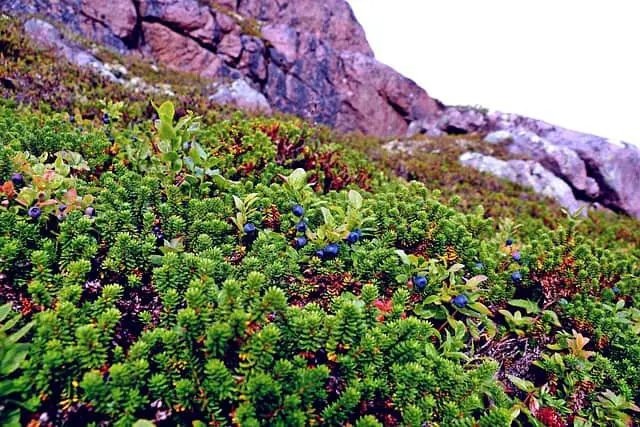
Wild Blueberries (Vaccinium spp.)
Wild blueberries are a true delight for those who savor the taste of these petite, deep-blue berries. They thrive in rich soil and can often be found in forested areas. Unlike their cultivated counterparts, wild blueberries offer an intense burst of flavor and are ideal for both fresh consumption and baked goods.
You’ll find wild blueberries in Alabama in July and August.

Huckleberries (Gaylussacia spp.)
With compound leaves and sweet berries, huckleberries are a sought-after treat for foragers. These berries, often dark blue to black in color, grow in acidic soils, especially in wooded areas. They’re sweet, tart, and high in vitamin C and antioxidants. They tend to grow in the same area as blueberries in Alabama, and sometimes people confuse the two.
You’ll find huckleberries ready to pick from June to August.
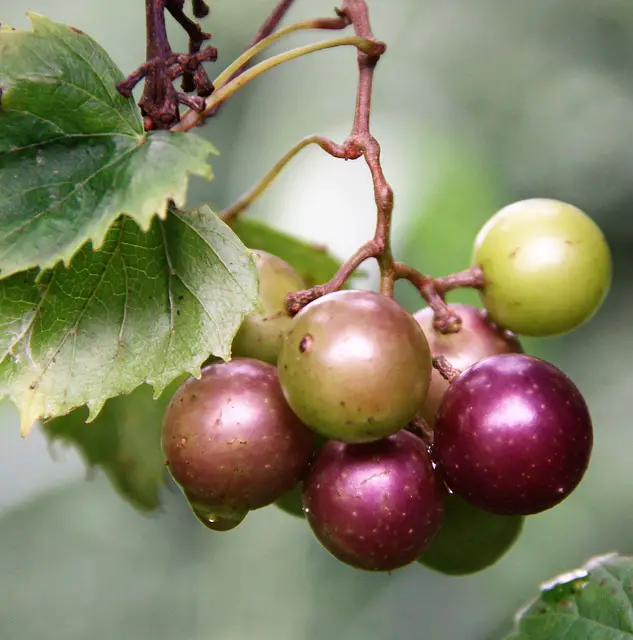
Muscadine Grapes (Vitis rotundifolia)
Muscadine grapes are delicious and unique. These grapes thrive on the vines in the southern United States, including Alabama. They are commonly found growing along fences, trees, and in open spaces.
You’ll recognize muscadine vines with their heart-shaped leaves. The berries are bigger than the grapes you’re used to seeing at the grocery store. They have seeds. You can eat the berry whole when it’s a ripe, dark purple. They’ll often fall right off the tree when they’re ready to be eaten. You’ll find them ready as early as mid-June and as late as October.
You can also use muscadines in your baking. Lots of people love these berries for jellies, jams, and pies.

Raspberries (Rubus spp.)
Raspberries are a bit less common in Alabama’s wild, but they can still be found. Look for them along trails, in fields, and near forests. Their delicate red berries are a delightful find, packed with vitamins and antioxidants.
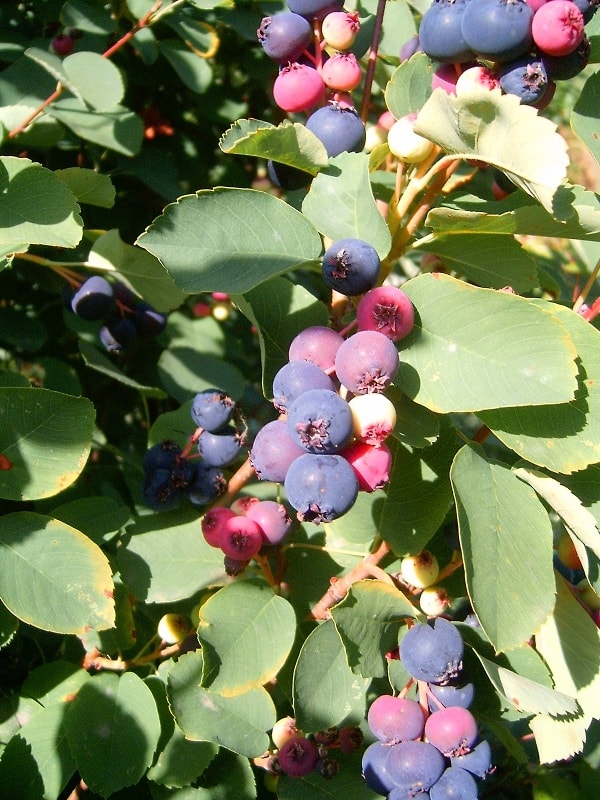
Serviceberries (Amelanchier spp.)
Also known as juneberries, serviceberries produce berries that resemble blueberries but with a slightly different taste. Their white flowers appear in early spring on deciduous shrubs or small trees. These berries are often used in pies and jams, offering a unique flavor profile.
When you first see serviceberries, they will be a pink color, but don’t be fooled. You aren’t going to enjoy eating serviceberries until they turn dark blue or purple in July or August. Occasionally you’ll see serviceberries in June, but if you do, make sure their color has fully developed before you pick them.
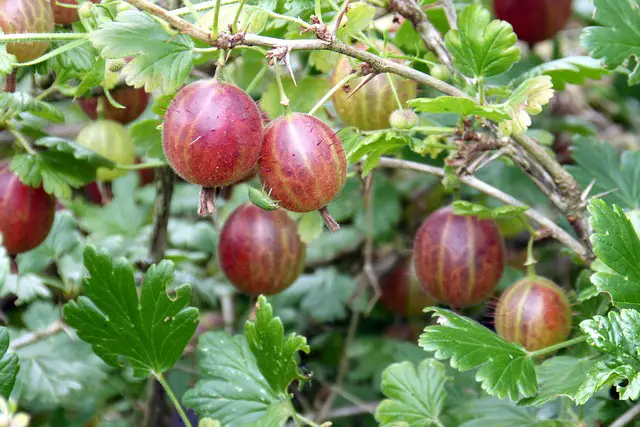
Gooseberries (Ribes curvatum)
You’ll find gooseberries in northeastern Alabama. These treats ripen in July and August. They grow on rocky slopes or deep in the forest on shrubs of about five feet in height, though they may be more like three feet, depending on the shrub. The fruits may be green, but they’re normally purple.
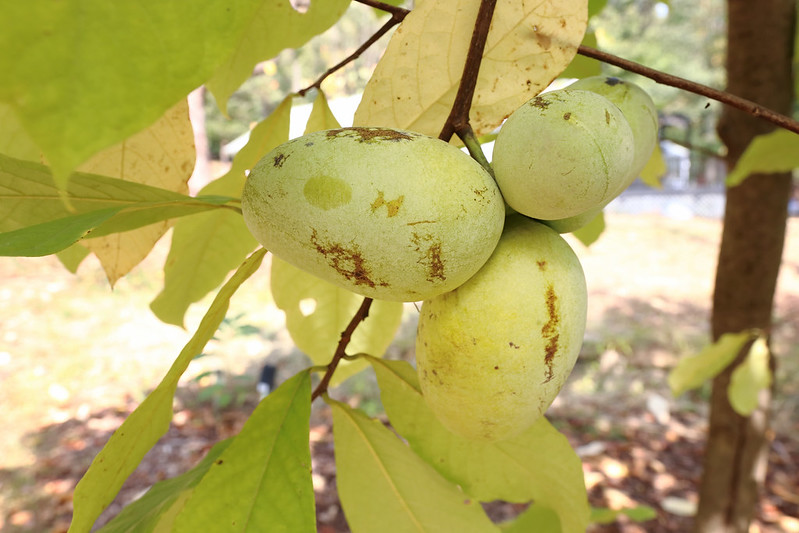
American Pawpaw (Asimina triloba)
The American Pawpaw has the enticing name of “the banana tree of North America”. It is the only true tropical fruit native to the continental United States. The pawpaw fruit is an oblong yellowish-green berry that is 2-6 inches long, 1-3 inches wide, and weighs around 0.7 -18 oz. Several black seeds are embedded in the soft pulp. These edible fruits begin developing after the plant’s flower; in the early stages, they are green, maturing by September or October to yellowish green or brown. The ripened fruit is fully ripe after it falls naturally from the tree.
Its unusual fruit combines a banana-like flavor with a custard-like texture. It is rich in nutrients like vitamin C, magnesium, iron, phosphorus, and potassium. In addition to the delectable fruit, pawpaw trees produce beautiful blossoms and imposing woody structures that are a favorite in home gardens.

Rose Hips (Rosa spp.)
Wild roses grace the landscapes of Alabama with their beauty and provide a bonus of edible ripe red rose hips. These round, reddish-orange fruits can be found on small trees and shrubs.
You will find pink and white roses growing wild in Alabama. The flowers can be used in teas. If you pick the flowers, you won’t get berries. The flowers can be harvested in the late summer. The ripe red rose hips appear in the late fall through the winter.
Look for wild roses along forest edges, old fields, in open meadows, and even in residential areas. Rose hips are rich in vitamin C, which is essential for a healthy immune system. They can be used in teas, jams, jellies, or dried for future use. Keep in mind that not all rose hips are palatable, so make sure to positively identify the wild rose before harvesting.
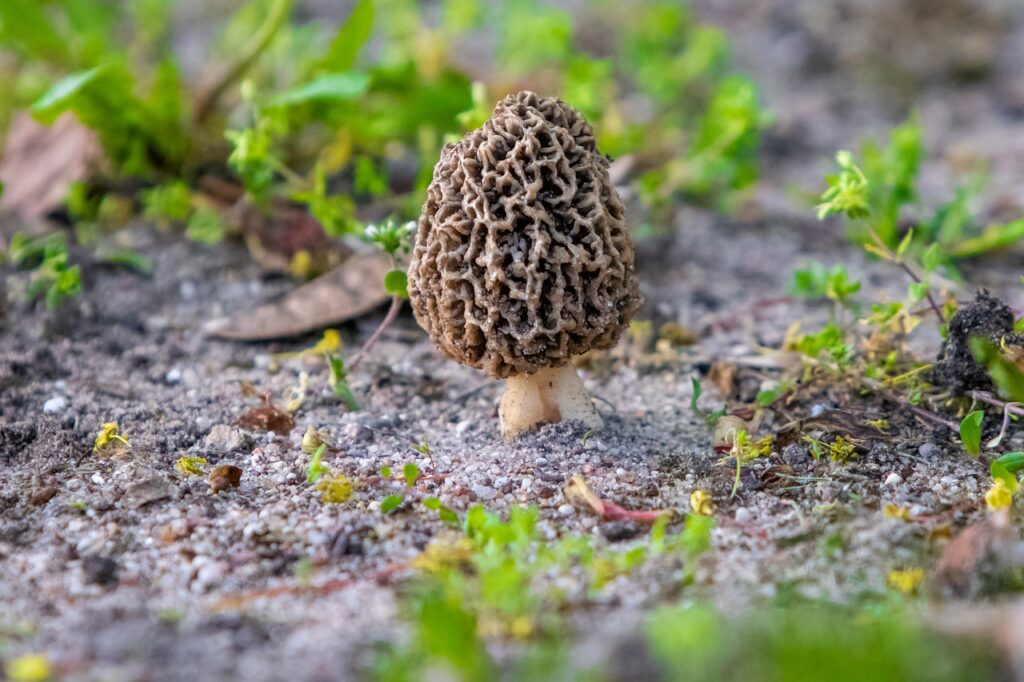
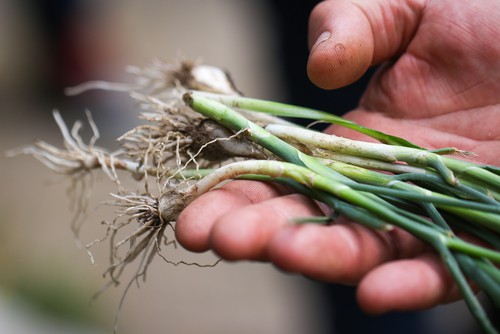

Other Wild Edibles in Alabama
There are a few other notable wild edibles you’ll come across while foraging in Alabama. Of course, there are morel mushrooms, a truly delicious and wonderful find.
You’ll also find Stellaria media, more commonly known as chickweed. You can safely eat the stems, leaves, flowers, and seed pods from chickweed. Chickweed is great when used in salads or even made into a pesto. This plant is plentiful in Alabama and nutritious. It is likely that the reason Chickweed has never been a successful commercial crop is that it doesn’t refrigerate well, so you’ll want to eat chickweed soon after you pick it. If you’re picking a lot at once, you’ll want to have a recipe for pesto or a soup that keeps well so you can use it as soon as possible.
You’ll find various cattail species in Alabama that are also edible. These plants are easy to find and plentiful. Their many different parts can be consumed at different times of the year. Learning how to cook the common cattail and enjoy it can really add a lot of opportunity for wild edibles in your kitchen.
You’ll also find plenty of wild onions in Alabama. This is a great find because it’s a delicious seasoning and can be added to lots of recipes. You can toss wild onions into a stir fry or roast them in the oven with potatoes for a great side dish. Keep in mind that wild onion is easy to confuse with other plants, so you’ll want to bring a field guide, check more than one source, and make sure you really have wild onion in your hands.
Allergic Reactions and Safety
Foraging novices should be aware of a potential allergic reaction. While most wild berries are safe to consume, some individuals might have sensitivities. This can especially be true for the leaves of some plants. You may find that you can safely pick and touch the leaves, but they give your friend a rash. The best way to prevent an allergic reaction while picking these edible berries is to wear long sleeves.
As for trying berries, it’s advisable to sample a small amount of any new berry before indulging in larger quantities. Furthermore, familiarize yourself with local poisonous berries to avoid any mishaps. Always check more than one source before trying a berry to be sure that it isn’t poisonous.
As mentioned above, when discussing wild blackberries, you should also be mindful of where plants are growing. If they’ve been treated with herbicide or constantly exposed to exhaust fumes, the plant may be full of pollutants. This is a more serious concern with plants that absorb these things. For instance, a banana has a thick skin protecting the edible part, so it’s not as likely to be impacted by things in its environment. A leafy green-like chickweed will absorb everything nearby. Berries also have thin skins and can absorb a lot of pollutants. Be mindful and use your best judgment when making these decisions.
Best Practices for Foraging in Alabama
When setting out on a berry-picking treasure hunt, it’s best to be well-prepared. Equip yourself with a sturdy basket, breathable clothing, and a field guide to help you accurately identify the berries you encounter. Opt for comfortable hiking shoes, as you might need to navigate various terrains to discover hidden berry patches. Avoid overharvesting; leave some berries for local wildlife and future foragers.
Wild Plants and Edible Uses
While berries steal the spotlight, many wild plants in Alabama have edible parts beyond their fruit. Compound leaves, a feature of many wild plants, often help in identification. Learning to recognize edible plants like wild garlic, dandelion, and chickweed can diversify your foraging experience. Incorporating these into your diet can offer new flavors and nutritional benefits.
Exploring Alabama’s wild berries is a thrilling way to connect with nature’s offerings. From the early spring emergence of white flowers to the late spring and summer bounty of delicious berries, the state’s diverse landscape provides a playground for foragers, hikers, and outdoor enthusiasts. As you embark on your berry-hunting adventures, remember to bring a field guide to help identify these treasures and be mindful of the native ecosystem. Whether you gather them for a healthy snack, culinary creations, or simply the joy of discovery, Alabama’s wild berries are a true gift from the natural world.
Recent Posts
The only venomous snakes in Washington State are Northern Pacific Rattlesnakes. The Northern Pacific Rattlesnake (Crotalus oreganus oreganus) is a sub-species of the Western Rattlesnake. Anyone...
Skunks are not classified as true hibernators. But they go into a state of torpor when the weather gets cold. Skunks are light sleep hibernators, along with opossums, bears, and raccoons. ...
